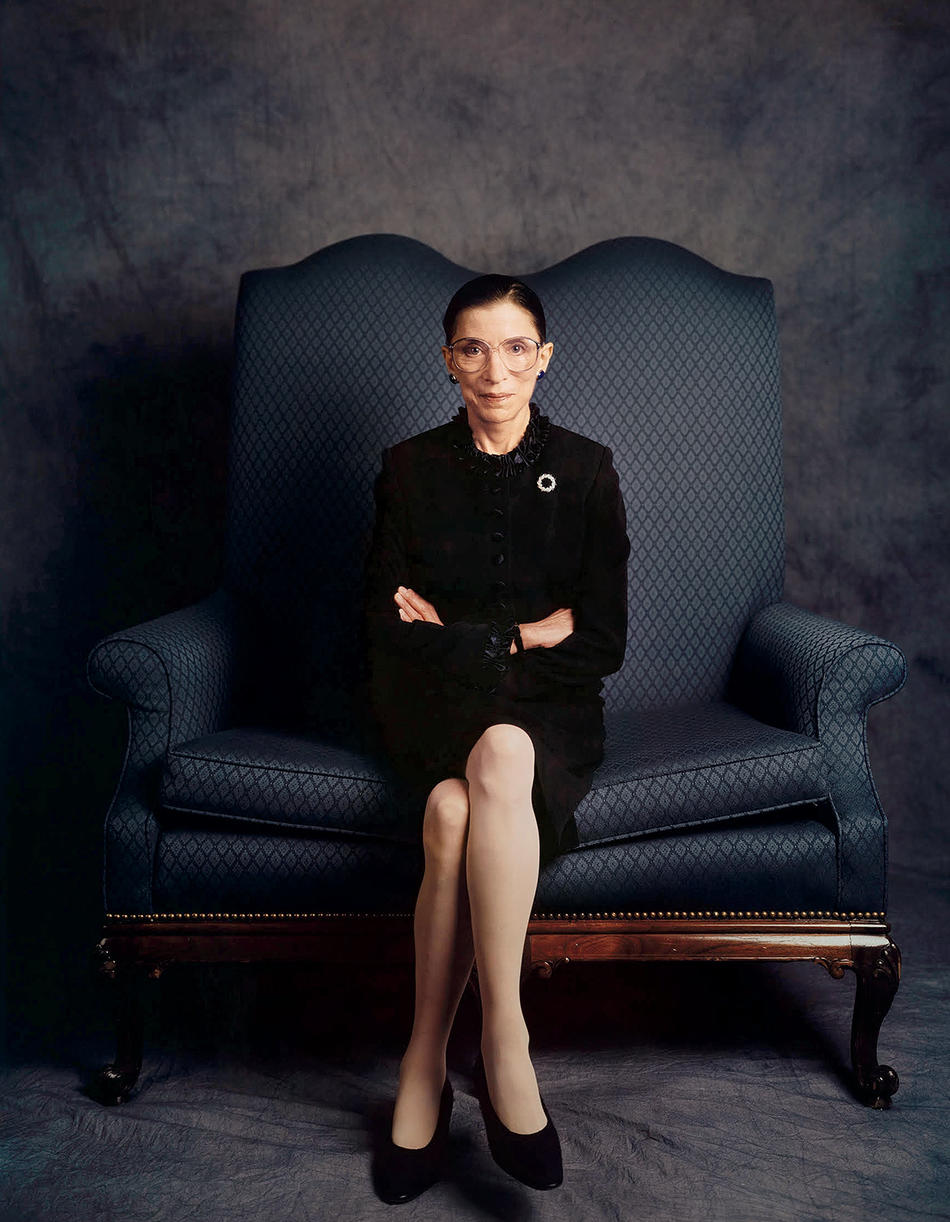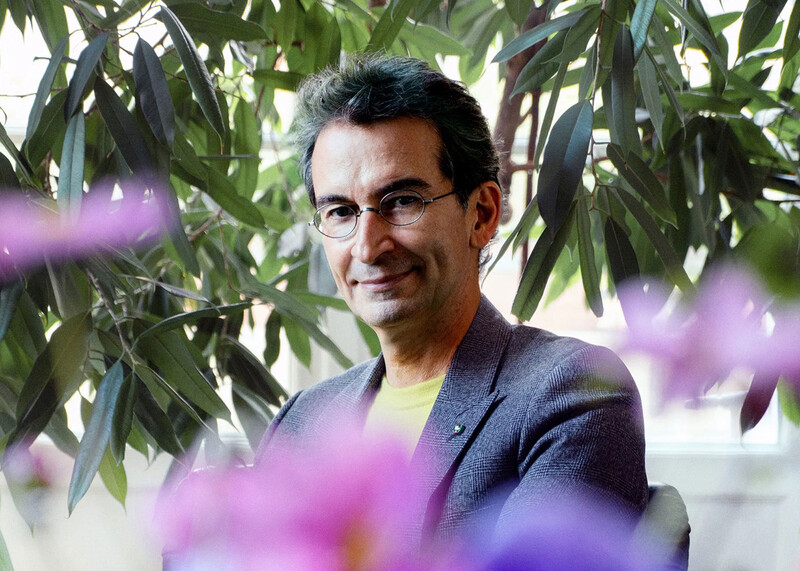After her death in September, flowers and handwritten notes addressed to Ruth Bader Ginsburg ’59LAW, ’94HON piled up at the base of the Alma Mater statue on the Low Plaza steps. Apart from a statue of Ginsburg herself, there could hardly be a more appropriate spot to honor the Supreme Court justice who finished at the top of her class at Columbia Law School and was Columbia’s first female tenured law professor.
Long before she became the second woman on the high court — before the incisive, literate opinions and echoing dissents, before the lace collars and pop-culture stardom — Ginsburg gained wisdom on Morningside Heights. Born in Brooklyn, she went to college at Cornell and had completed two years at Harvard Law School when her husband, Marty, a tax lawyer, got a job in New York. Ginsburg transferred to Columbia, a step that would transform her life and eventually the country.
A shy, quiet student with a commanding intellect and relentless will, Ginsburg relished her time on campus. She joined the law review and made it a point to speak up in her male-dominated classes, even as she felt, when answering questions, the burden of representing all women.
While any man with Ginsburg’s academic record could expect a clerkship in a federal appeals court or the Supreme Court, Ginsburg, a woman and a mother of a four-year-old daughter, was passed over. Answering this injustice, law professor Gerald Gunther ’50GSAS contacted judges in the Southern District of New York to endorse his star pupil, and Ginsburg was finally hired by Judge Edmund L. Palmieri 1926CC, 1929LAW.
But even after her clerkship she couldn’t get a job with a law firm, and in 1961, when law professor Hans Smit ’53GSAS, ’58LAW asked her to coauthor a book on the Swedish legal system as part of Columbia’s Project on International Procedure, Ginsburg said yes. It was Smit who urged her to speak in public and write for law journals, and who kindled her passion for civil procedure, the body of rules governing civil litigation. When the book was finished, Ginsburg joined the faculty of Rutgers Law School, where she stayed for nine years until Columbia recruited her in 1971. That year, as a volunteer lawyer for the ACLU, she cowrote the petitioner’s brief in Reed v. Reed, challenging an Idaho law that favored men in the appointment of executors of estates. The Supreme Court ruled unanimously for the plaintiff, Sally Reed.
Ginsburg returned to Columbia with purpose. Shortly after accepting the offer, she sent a letter to University president William McGill ’70HON, noting that a statement attributed to McGill in the New York Times implied that Ginsburg had been hired to satisfy federal diversity requirements rather than on her merits. With precision and tact, Ginsburg explained that the idea that women sought “reverse discrimination” proceeded from a flawed assumption of male superiority. Later in 1972, she campaigned against unequal retirement benefits at the University (women received less than men) and, as the law school’s representative in the University Senate, supported an equal-pay salary review.
Gender discrimination was at the heart of her work. In 1973, again for the ACLU, Ginsburg argued her first case before the Supreme Court in Frontiero v. Richardson, which disputed the legality of unequal military benefits for men and women. To prepare for her nerve-racking debut she enlisted Columbia professors Benno Schmidt Jr. ’76HON and Harold Edgar ’67LAW, along with her students, to pepper her with questions. The work paid off: her ten-minute address to the Burger Court led to an 8–1 ruling that the unequal benefits were unconstitutional.
Of the six cases Ginsburg argued before the court in the 1970s, advocating for both women and men seeking equal treatment under the law, she won five. The decisions rippled through government agencies. By the time President Jimmy Carter appointed her to the US Court of Appeals for the DC Circuit in 1980, ending her teaching career, Ginsburg had already reshaped society. “She’s one of a handful of people in American history who fundamentally changed the law,” says David Schizer, a Columbia law professor and former law-school dean who clerked for Justice Ginsburg in 1994–95. “That’s a monumental achievement.”
When Ginsburg’s name was in the mix for the Supreme Court in 1993, Columbia president Michael Sovern ’53CC, ’55LAW, ’80HON lobbied President Bill Clinton on her behalf. Ginsburg’s legal genius won Clinton over, and she was nominated and overwhelmingly confirmed.
As an associate justice, Ginsburg adjudicated with sober regard for the real-world effects of the law on regular people, crafting a body of penetrating, rigorously researched majority opinions and dissents aimed at jurists, lawmakers, and citizens alike. “Her mantra was ‘Get it right and keep it tight,’” says Schizer. “She scrutinized every word and would write and rewrite until she’d said exactly what she’d wanted to say.”
Ginsburg’s clerks describe her not only as a brilliant jurist but also as a loyal mentor who led by example. “She held herself to an extraordinarily high standard and taught us how to bring that deliberate care to our work,” says Columbia law professor Gillian Metzger ’96LAW, who clerked for Ginsburg in 1997–98. “It’s a lesson her clerks carry: we all have a little RBG on our shoulders.”
Likewise, millions of Americans stand on her shoulders. To honor this legacy, Governor Andrew Cuomo named a commission to supervise the creation of a Ginsburg statue in Brooklyn. The commissioners include Metzger and Columbia law professor Jane Ginsburg, Justice Ginsburg’s daughter. The statue will be a site of inspiration and hope, much as Alma Mater was in September, where among the many tributes was a note from a nine-year-old girl:
Dear Ruth Bader Ginsburg,
I’m using my fountain pen for you. You are such an inspiration to girls and women. It’s devastating to hear you died. But death does not mean that you’re gone. You are with us Americans still.
This article appears in the Winter 2020-21 print issue of Columbia Magazine with the title "Monumental Justice."




